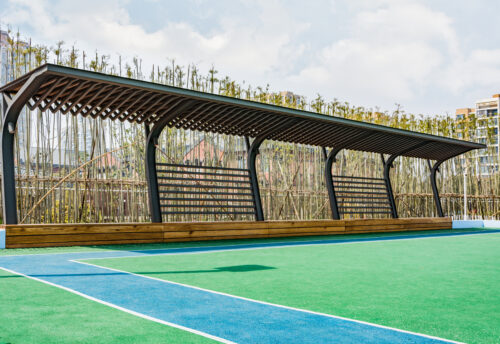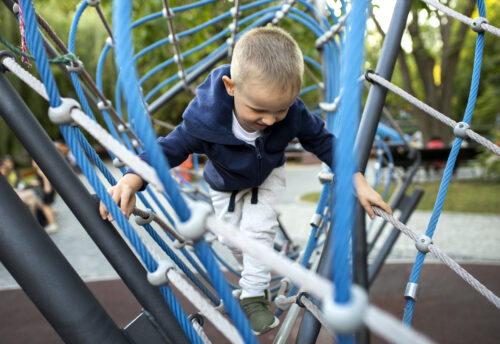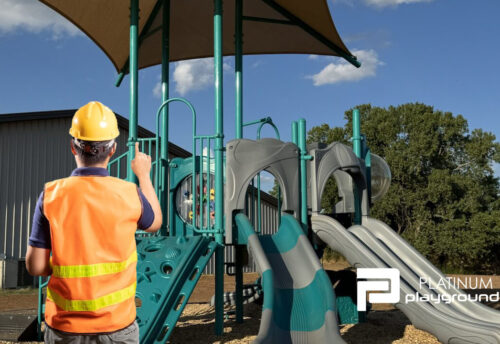Choosing Commercial Playground Equipment for Your Space: A Guide to Getting it Just Right
So, you’re in the market for some playground equipment, huh? Maybe you’re tasked with revamping a local park, setting up a play space for a school, or putting in a playground for a community center. Whatever the case, you know one thing for sure: this is no “one-size-fits-all” deal. Creating a great play space means thinking through every detail, from the types of equipment to the age group of the kids and even the space you have to work with.
Luckily, Platinum Playgrounds has you covered with all the info you need to make smart choices without breaking a sweat. (Well, maybe just a little.) So grab a coffee, kick back, and let’s break down the essentials of choosing the perfect playground equipment setup.
Step 1: Understand Who’s Using the Playground Equipment
Your first job is to consider the kiddos. We’re talking ages here. Knowing the target age range is like knowing the right flour for your favorite bread recipe. It’s foundational, and it makes everything come together.
Playground Equipment for the Littlest Adventurers (Ages 2-5)
This age group is all about testing their newfound mobility, balance, and coordination, but they’re not yet ready for the big-kid equipment. For these pint-sized players, safety and accessibility are everything. Think short slides, gentle swings, low platforms, and easy-to-grip handholds. You want playground equipment that helps them build motor skills without putting them at risk of, say, scaling a mountain-sized rock wall.
These younger kiddos thrive on smaller-scale versions of classic play equipment:
- Tiny Slides: Short, gentle slopes that don’t turn into bobsled runs.
- Bouncy Spring Riders: Those fun little seats on springs? Yes, they still hold the crown as playground favorites.
- Activity Panels and Sensory Stations: These are great for little hands and minds, adding interactive elements that keep the youngest players engaged.
When planning a playground for 2-5-year-olds, also consider safety surfacing, like rubber or turf, and make sure everything is close to ground level. Their imaginations can fill in the rest.
The Fearless Fives to Twelves (Ages 5-12)
These kids want some adventure. They’re climbing, jumping, swinging, and sliding with full enthusiasm, which means it’s time to bring in equipment that’s up to the challenge. For this age group, you can look at taller and more complex play structures that keep them entertained and challenged, without a trip to the ER.
Key equipment ideas for ages 5-12:
- Monkey Bars and Climbing Walls: Great for agility and upper body strength.
- Twisty Slides and Tunnel Slides: For that added excitement without a “too-fast” scare.
- Swings, Swings, and More Swings: Belt swings, group swings, and disc swings provide endless fun.
Older kids also love balance beams, rope courses, and equipment that offers a bit of a mental challenge, like spinning maze panels. Adding multi-purpose playground equipment for imaginative play (think pirate ships or jungle-themed setups) is also a big hit.
Curious about what’s hot and what’s not in playground equipment? Check out, “Top Trends in Commercial Playgrounds“.
Step 2: Measure Out Your Space
Now that you know who will be using the playground, it’s time to take a close look at your space. Playground equipment can vary dramatically in size, and some equipment has specific space requirements to meet safety standards. Here’s a quick rundown on how to maximize your space and make sure you’re not overcrowding—or under-utilizing—the area.
Safety First (a.k.a. “Fall Zones”)
One of the most important things to consider is spacing out equipment for safety. Fall zones are basically the buffer areas around each piece of equipment where kids are likely to land if they fall. For example, a swing set needs enough space to swing forward and back, so no one’s running into it mid-flight. Each piece of equipment comes with recommended safety clearances, which Platinum Playgrounds will help you figure out during the planning phase.
Playground Equipment Proportional Design
Small space? No problem! Large space? Even better. But regardless of size, you need to create balance in the layout. Here are a few tips:
- Divide and Conquer: Separate equipment by age group if space allows. This prevents a toddler from wandering into the middle of a high-energy game of tag.
- Sightlines: Maintain clear sightlines for supervisors. This is easier if you cluster similar-age equipment together and avoid visual obstructions.
- Zones for Play Variety: Create distinct zones within the playground for different types of play. For example, you could have a climbing zone, a swing zone, and an interactive play zone.
Planning out the space ahead of time lets you maximize fun while ensuring everyone’s safety.
Step 3: Let’s Talk Accessibility and Inclusivity
Today’s playgrounds are designed to be welcoming to every child, and Platinum Playgrounds is no exception. Accessibility is key, and it benefits not only children with disabilities but everyone who comes to play. Here’s how to create an inclusive, accessible playground.
ADA-Compliant Playground Equipment
By choosing ADA-compliant equipment, you’re making the playground accessible to children of all abilities. Some popular accessible playground equipment options include:
- Accessible Swings and Seats: Swing options that have back support or allow wheelchair access.
- Ground-Level Play Features: These allow kids who use wheelchairs to play alongside their friends.
- Ramps and Transfer Points: Providing access to elevated play areas and slides.
Sensory Play Elements
Inclusive playgrounds aren’t just about physical accessibility. Sensory play elements, like musical panels, textured surfaces, and spinning elements, appeal to children with sensory processing needs and offer more ways to play for everyone. These features make the playground more dynamic and welcoming to kids with a wide range of needs.
Open Pathways
A well-designed inclusive playground should have clear, open pathways that allow for easy movement from one area to another. Wide walkways and gentle inclines make it easier for kids, caregivers, and wheelchairs to navigate the playground without obstruction.
Step 4: Choosing the Right Materials and Colors
Playground materials go beyond durability—they also impact the overall look, feel, and maintenance needs of the playground. From the aesthetic to the practical, here are some things to keep in mind.
Material Durability
Playgrounds are outdoor spaces, so everything you install has to stand up to the elements. Powder-coated metal, high-density plastic, and UV-resistant coatings are popular choices for a reason—they last! If your playground is in a particularly sunny area, opt for materials with UV protection to keep colors bright and to avoid heat build-up.
Eco-Friendly Options
Sustainability is becoming more popular, and you can find playground materials made from recycled plastic or sustainable wood options. Eco-friendly materials reduce the playground’s environmental impact and still deliver great durability and safety.
Playground Equipment Color and Design
Bright colors are a must for kid-friendly spaces, but they’re also an opportunity to reinforce a theme or connect the playground with the local community vibe. Bold reds and blues are classics, but natural tones like greens and browns can help a playground blend into a park setting or wooded area.
Step 5: Playground Equipment Customization for Maximum Impact
Every playground should be as unique as the community it serves. By adding customized elements, you’ll create a space that reflects local character, culture, or even the school mascot if it’s a school playground. At Platinum Playgrounds, customization options are nearly endless.
Theming and Branded Elements
Theming transforms an average playground into a destination. From pirate ships to jungle-themed forts, themed playgrounds create an immersive experience that keeps kids coming back. Custom branding, like logos or school colors, can also be incorporated into playground equipment for that extra local touch.
Unique Play Structures
If you want to add something truly unique, consider custom play structures that make your playground stand out. Think treehouses, mazes, or even kid-friendly obstacle courses. Not only do these structures add a wow factor, but they’re also engaging for kids of all ages.
Protect your investment with professional maintenance and repair. Learn more about “Playground Maintenance: Essential Tips“.
Bringing It All Together

Creating a playground is about more than just choosing a few slides and swings. It’s about building a community space that’s safe, fun, and accessible for everyone. By planning carefully, selecting age-appropriate and inclusive equipment, and working with experts like Platinum Playgrounds, you’re setting up a playground that’ll be a favorite for years to come.
So whether you’re planning for a small neighborhood park or a sprawling community play area, don’t stress. Platinum Playgrounds is here to help you navigate the choices and bring your vision to life. Contact us today to learn more about designing the perfect playground for your space and to get a quote. After all, a great playground doesn’t just happen—it’s planned to perfection!




